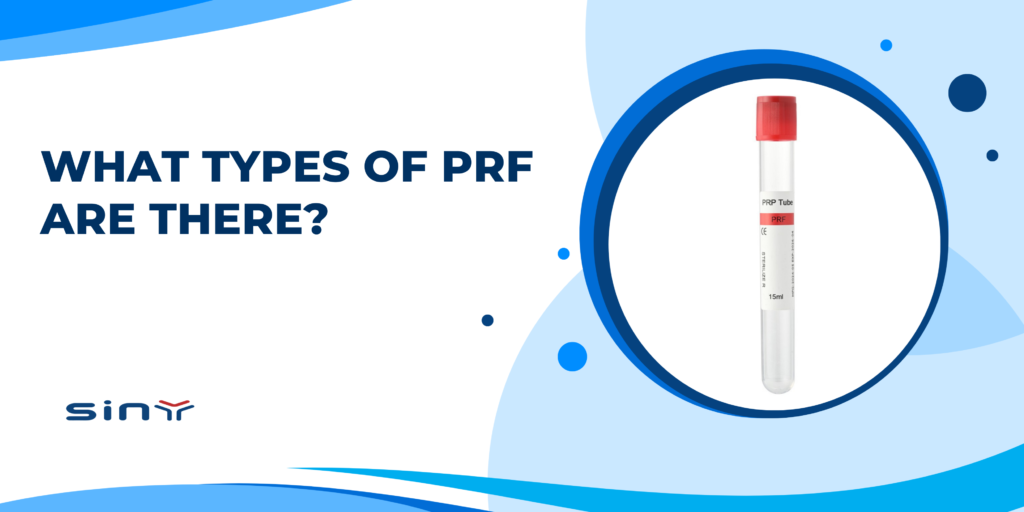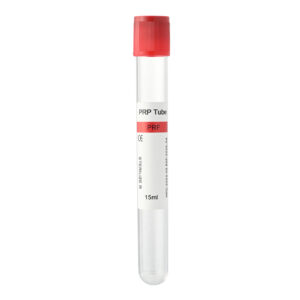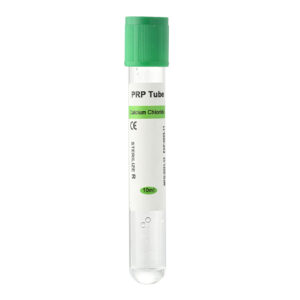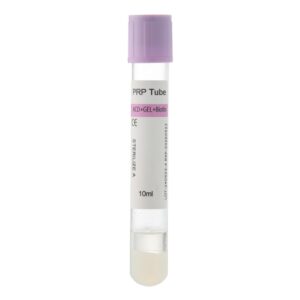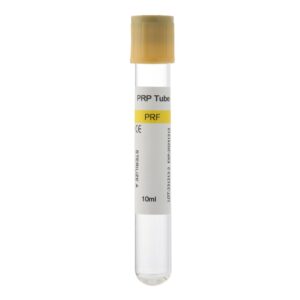What types of PRF are there? Platelet-Rich Fibrin (PRF) comes from a patient’s blood. Without adding anticoagulants, we spin the blood at low speed to trap platelets, white blood cells, and growth factors inside a natural fibrin matrix. Unlike Platelet-Rich Plasma (PRP), PRF relies on the blood’s clotting, boosting compatibility, and allowing growth factors to release over time. This approach speeds up tissue repair and wound healing.
PRF Preparation Process
- Blood Collection
- Draw 5–10 mL of venous blood and place it into a plain PRF tube (glass or plastic, based on tube type).
- Centrifugation
- Standard PRF (S-PRF/L-PRF): Spin at about 700 g for 8–12 minutes to form a dense fibrin clot rich in cells.
- Advanced PRF (A-PRF): Use lower force (200–400 g) for 10–14 minutes to get a looser fibrin network that releases more growth factors.
- Injectable PRF (i-PRF): Spin very gently (60–200 g) for 3–5 minutes to produce a short-lived, liquid platelet suspension ready for injection.
- Harvesting
- After spinning, remove the middle PRF layer (clot or liquid) with sterile forceps, keeping red cells and plasma to a minimum for higher purity and activity.
Main Types of PRF Tubes
- L-PRF (Leukocyte- and Platelet-Rich Fibrin)
- Delivers a strong fibrin network loaded with white cells and platelets. It fights infection and supports new blood vessel growth—ideal for dental implants and wound healing.
- A-PRF (Advanced-PRF)
- Captures extra growth factors and white cells thanks to low-speed, longer spins. The looser network lets nutrients flow better, so clinicians can handle it quickly during soft tissue repair.
- i-PRF (Injectable-PRF)
- Produces a fluid platelet mix you can inject right into the skin or joints. It remains injectable for about 15–20 minutes, making it perfect for cosmetic treatments and minimally invasive therapies.
- H-PRF (Horizontal-PRF)
- Uses a horizontal centrifuge for even shear forces. It yields a more uniform cell and fibrin distribution, which can boost tissue regeneration.
- C-PRF (Concentrated Growth Factor)
- Relies on multi-step or gradient centrifugation to maximize growth factor yield, forming a dense membrane that suits bone defect repairs and tissue engineering.
- S-PRF (Standard-PRF)
- The classic method (700 g × 12 min) creates a moderate-density clot for routine use in both soft and hard tissue support.
- T-PRF (Titanium-PRF)
- Uses titanium-lined tubes to speed clotting and strengthen the fibrin network. It improves both biological activity and mechanical strength, making it great for bone regeneration and gum tissue management.
- CGF (Concentrated Growth Factor)
- Follows a special dual-spin protocol to concentrate growth factors in a gel form. It suits large-scale bone and soft tissue projects but demands precise equipment and skill.
Pros and Cons of Each PRF Type
- L-PRF
- Pros: High white cell and platelet content; strong infection defense; solid fibrin network.
- Cons: RequIt requires a speed centrifuge; tubethe s cost more.
- A-PRF
- Pros: Richer growth factor release; easy handling.
- Cons: Longer spin time may slow down busy clinics.
- i-PRF
- Pros: Liquid form works well for injections; user-friendly.
- Cons: Clotting happens fast; limited volume.
- H-PRF
- Pros: Uniform cell distribution; consistent results.
- Cons: Needs a horizontal centrifuge.
- C-PRF
- Pros: Peak growth factor levels; ideal for bone work.
- Cons: Complex steps; higher material cost.
- S-PRF
- Pros: Simple, affordable, readily available.
- Cons: Moderate growth factor output; average network density.
- T-PRF
- Pros: Robust fibrin structure; boosted bioactivity.
- Cons: Expensive titanium tubes; niche equipment required.
- CGF
- Pros: High growth factor concentration; excellent for large defects.
- Cons: Hard to standardize; operator skill matters.
How to Choose the Right PRF Tube
- Match tube type to your treatment goal: A-PRF or i-PRF for soft tissue; C-PRF/CGF for bone defects.
- Check your centrifuge: Horizontal machines unlock H-PRF; titanium-lined tubes create T-PRF.
- Consider speed: Choose i-PRF when time is tight; pick T-PRF when you need extra strength.
- Balance cost and availability: S-PRF offers low cost and easy sourcing; advanced tubes need more budget.
FAQ
Q1: Is PRF safe?
Yes. PRF uses the patient’s blood without additives, so it carries minimal risk of reaction or infection.
Q2: How soon must we use PRF after spinning?
Use solid PRF clots using the same procedure. Inject i-PRF within 15–20 minutes before it gels.
Q3: What makes PRF different from PRP?
PRF traps cells in a fibrin matrix, releasing factors slowly over time. PRP uses anticoagulants and activates quickly, giving a fast but short-lived boost.
Q4: Where do clinicians use PRF most often?
Dentistry (implants, periodontal repair), wound healing, bone reconstruction, cosmetic skin treatments, and joint injections.
Summary
By understanding each PRF tube’s prep steps, strengths, and ideal uses, you can choose the best option to support tissue repair. Whether for dental implants, soft tissue grafts, or cosmetic injections, the right PRF type boosts healing and patient results. For tube specs, handling tips, or expert advice, contact our team—we’re here to guide you every step of the way.

